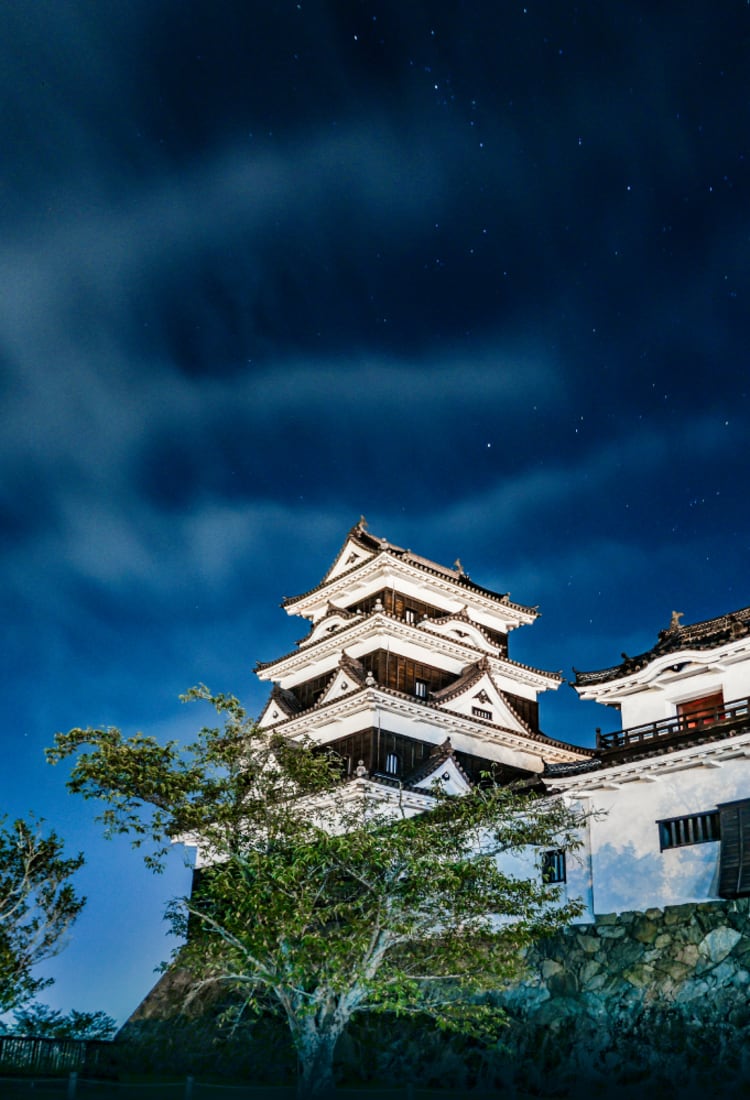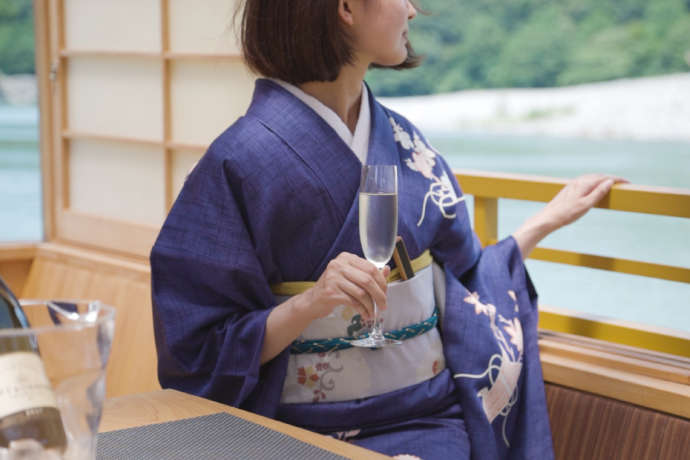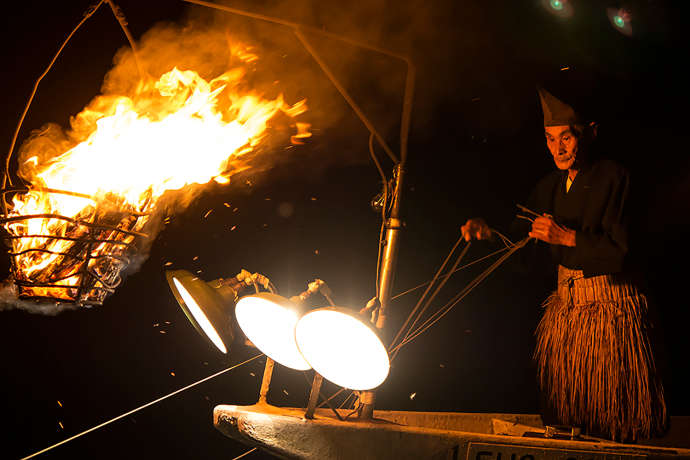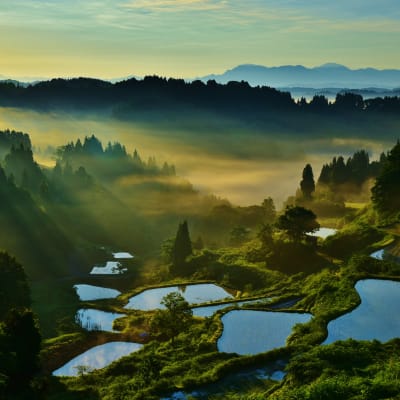
Castle Stays Ozu Castle Be the Lord of a Castle for a Night
Stay in a restored castle in the historical town of Ozu
You can visit many impressive castles in Japan, but Ozu Castle in Ehime offers the rare opportunity to stay in a castle for a night. The imposing four-story structure was built in the fourteenth century, overlooking the Hiji River in Ozu. A stay at the castle offers guests the chance to experience the life of the Kato daimyos (1617–1868), rulers of the Ozu Domain (present-day Ozu) for thirteen generations.

Experience the life of a daimyo lord, with a traditional welcome.
Ozu is about an hour’s drive southwest of Matsuyama on the western coast of Ehime. The town is dubbed the "little Kyoto” of Iyo (the ancient name of Ehime prefecture). Ozu flourished during the Meiji (1868–1912) and Taisho (1912–1926) eras, thanks to wax and silk production, and its status as a major port on the Hiji River. Wealthy merchants once built grand houses and elegant teahouses here, but as modern technology diminished the importance of its industries, the town’s grandeur faded. Now, thanks to the efforts of the community and the local government, Ozu’s identity as a “little Kyoto” is returning. The town has joined forces with Nipponia to create a bespoke hospitality experience that includes stays at the castle and several restored mansions and merchant houses around this charming castle town.

Ozu Castle overlooks the Hiji River.
A castle and town reborn
Like many castles in Japan, Ozu Castle’s prominence faded with the Meiji Restoration in 1868, when power was consolidated under the Emperor, and regional rulers were stripped of their powers and lands. The Kato family vacated Ozu Castle, and it fell into disrepair. The main tower of Ozu Castle was demolished in 1888 due to deterioration, leaving just the turrets. The local community worked to restore the donjon (main tower, or keep), which was completed in 2004. What visitors see is a faithful reconstruction in timber, using traditional construction methods. The restoration sparked interest in preserving historical buildings in Ozu, and Kita Management was formed to restore and protect the area’s architectural heritage. They engaged Nipponia to manage the hospitality side, and started turning abandoned abodes into accommodations, breathing new life into the town and encouraging more visitors to discover the area.

Rooms in the Sada building, a restored mansion, have views of Ozu Castle.
A night in a castle
Staying at Ozu Castle begins before you even arrive in Ehime. Staff from the Nipponia Hotel will help you plan your visit, arranging authentic experiences to make your stay unforgettable. From the moment you arrive in Ehime’s capital city Matsuyama, you will be treated like the lords of the castle, met at the airport, and whisked down the coast in a luxury car to Ozu, around one hour from the city.

Guests can play the role of the lord of the castle.

A troop of samurai welcome guests with the banners of the Ozu Domain.

Guests can use a private lounge to dress in samurai armor or kimono.
Guests are invited to relax in a comfortable lounge area in the grounds of the castle, to prepare for their journey back to 1617. They can dress in kimono or samurai armor if they wish. As the sun begins to set and the castle is closed to the public, the sound of a horagai conch shell horn, heard in a hundred samurai movies, makes the heart beat a little faster. A troop of samurai assemble, bearing the banners of the Ozu Domain. Guests can play the role of the lord of the castle and enter the grounds on horseback if they wish. After a rousing salute by samurai troops with matchlock rifles, the jodaikaro (chief retainer) hands the keys to the castle over to the acting castle lords.

The evening’s entertainment is a performance of kagura, a traditional form of dance and music.
Dinner is served in the Koran Turret, followed by the evening’s entertainment by a local kagura theater troupe. This ancient form of dance and music is an act of worship dedicated to Shinto deities. Performers wearing striking masks and dazzling costumes tell ancient legends through dance. If the moon is out, you can climb up to the second floor of the turret and view the moon while sipping sake. The sleeping area is a high-ceilinged room laid out with comfortable futon bedding on fresh tatami matting.

Sleep on comfortable futon beds in the castle.
Making it work
Behind the scenes, a dedicated team of staff make the magical stay possible. After the castle is closed to the public, there is just one hour to turn it into an accommodation. Due to fire regulations there is no kitchen on-site, so meals are prepared nearby, and the finishing touches are added before serving. As a faithful reproduction of the castle as it was in the sixteenth century, there are no baths and toilets on-site, so a luxury lounge with a generous soaking tub, full bathroom, and sofas has been built in the castle compound.
Breakfast by the river
In the morning, a traditional Japanese breakfast is served at Garyu Sanso, a nearby cliffside villa perched over the Hiji River. The site comprises three sukiya-zukuri-style buildings characterized by their refined simplicity and rustic design. The complex is registered as an Important Cultural Property of Japan. The elegant villa has a thick, thatched roof, sliding doors that open to frame views of the river, and wide verandas overlooking the gardens. Two small tea pavilions, Furo-an and Chishi-an, are spaces to relax and watch the flow of the river below. Garyu Sanso was constructed in the Meiji era (1868–1912) by Torajiro Kochi (1853–1909), a wealthy merchant trader, who was inspired by the seventeenth-century Katsura Imperial Villa in Kyoto. The gardens borrow the distant scenery of the mountains, forests, and the Hiji River.

Breakfast is served in the Garyu Sanso, a serene villa overlooking the Hiji River.

Spend some time exploring the gardens and pavilions of Garyu Sanso.
Stay in town
While Ozu Castle is impressive, the real charm of staying in the area is the town itself, which fans out from the castle walls. Accommodations have been created from beautiful old mansions and merchant houses, some dating from the Edo period (1603–1867). Ozu itself becomes the hotel, welcoming guests with authentic experiences. These homes, often neglected and left empty, are borrowed from the owners and carefully restored, bringing them back to life. The owners have the option to take them back in several years or let them remain as part of the hotel. At present, guests can stay in Sada, a restored mansion with views of the castle, which also houses the hotel reception and restaurant; Oki, the former residence of a wealthy wax merchant; Tune, a former restaurant converted into stylish accommodations; and Miti, a former residence of the Kato family. The plan is to do more than just save endangered structures. By employing local craftspeople, jobs and valuable skills are retained in the area. The hotel works with local farms and producers to supply fresh produce for the restaurant and amenities for the hotel such as locally made toiletries and organic linens.

Town accommodations comprise restored mansions and merchant houses near the castle.

Explore the historical streets of Ozu at leisure.
In keeping with the philosophy of a decentralized hotel, there are currently 11 guestrooms, a reception, and restaurant, spread across nine buildings, encouraging guests to explore the area on foot. Step outside your “house,” and find small craft ateliers, cafes, and temples right on your doorstep. Each room has its own personality, mixing period details and modern comforts. Choose a stylish room in the center of the historic town, or the luxurious seclusion of a private mansion with manicured gardens.

Rooms combine the original character of each building, with modern comforts.

Enjoy traditional accommodations, adorned with local crafts.
Meals are a leisurely affair at Le Un, the hotel’s restaurant, at the foot of the castle. Dishes fuse Japanese and French techniques, with a focus on fresh ingredients sourced from local farms and the nearby Seto Inland Sea. Meals are served on locally made Tobe pottery, enhancing their visual appeal. At night, diners can view the illuminated castle as they sip local sake.


At Le Un, the hotel’s restaurant, guests can enjoy fresh produce from local farms.
Life on the water
Ozu sits on a major river, close to the Seto Inland Sea. Take a private cruise along the river on a houseboat, sipping wine or sake as you float past the gardens and the fairytale Furo-an teahouse at Garyu Sanso, or venture out on a summer night to watch traditional ukai cormorant fishing. Guests can watch from a nearby boat as the cormorant master, using the firelight on his boat to attract fish, skillfully manages his team of cormorants, who dive for sweetfish (ayu) and deliver them to his boat. It is a fishing technique that has barely changed in 1,300 years. If you yearn for open waters, the hotel concierge can arrange a charter yacht to sail you around the Seto Inland Sea.

Cruise the Hiji River on a private houseboat.

On summer nights, guests can watch ukai, or cormorant fishing, by firelight.
Exploring Ehime’s history
Learn more about the area at the Museum of Ehime History and Culture, about 30 minutes from Ozu. The museum is in a striking modern building, borrowing elements from prehistoric architecture. The museum features engaging exhibits on Ehime’s history. An exhibition of full-scale dwellings depicts the way people lived in Ehime, with examples from the paleolithic period, right through to the Meiji era (1868–1912). A folklore section explores Ehime’s rich traditions of festivals and performing arts, with full-size portable shrines and traditional costumes, and information about the Shikoku Henro, the famous pilgrimage route around the island of Shikoku, that involves visiting 88 temples.

Exhibits at the Museum of Ehime History and Culture include portable shrines and traditional costumes.
Natural wonders
Ozu is an ideal base for exploring Ehime. The fishing town of Yawatahama is worth a day trip, to explore its citrus orchards and beautiful coastline. Head to Cape Suwazaki, a peninsula south of the town center, to explore its forest paths and enjoy spectacular views of the Seto Inland Sea. The easy two-kilometer trail to the tip of the peninsula has views of cliffs, coves and distant islands. Toward the tip of the peninsula, a small white tower marks the spot where the town holds an annual memorial ceremony for all the fish that are caught, and to thank the sea for its bounty.

Explore Ehime’s beautiful coastline, with views of the Seto Inland Sea.

Ehime is famous for its orchards of mikan oranges, which cover the hills around Yawatahama.
Measures against the spread of COVID-19
Ozu Castle is only available to one group at a time. The Nipponia Hotel provides a private atmosphere and decentralized accommodations. It is possible to complete the check-in process in your room. All areas of the castle and hotel are regularly disinfected and ventilated, alcohol disinfectants are placed in common areas, tables in the dining area are spaced apart, and breakfast can be served in your room.
If you are unable to visit Ozu Castle and the town at the moment, you can enjoy its beauty through a virtual experience. Explore the castle, the town, and Garyu Sanso through immersive, 3D videos. https://www.ozucastle.com/concept/vr/
Please note that certain programs and events may have been canceled or temporarily suspended due to COVID-19. Please check the hotel’s website or inquire in advance.

































































